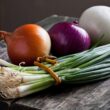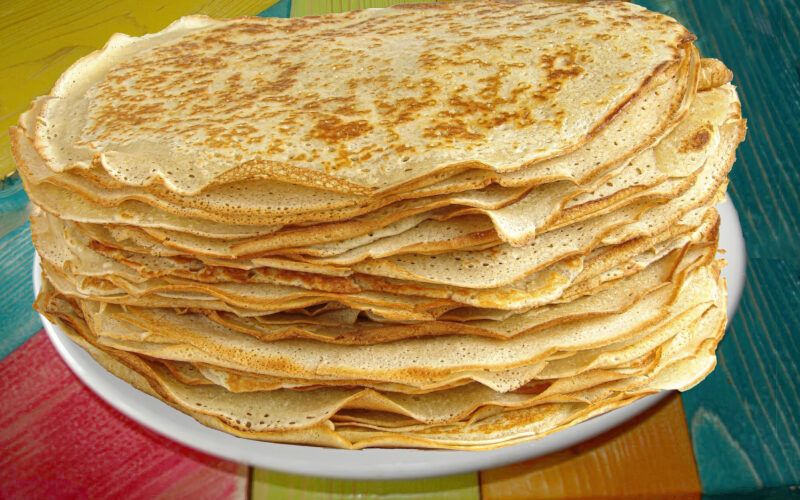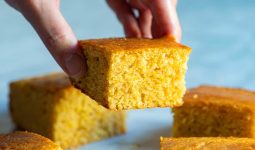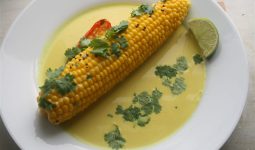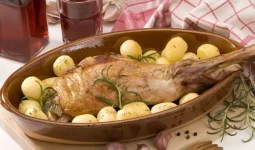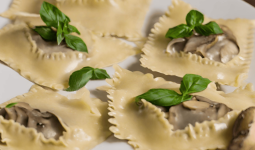Pancakes are one of the standard breakfast options in many households today.
They are easy to make and provide a wide range of nutritional value. You can prepare pancakes in different ways.
While they’re delicious on their own, you can customize them with your favorite add-ins.
Where kids at a younger age may prefer a mix with chocolate chips for a special treat, and the older ones may sometimes be eaten with fresh or frozen blueberries; banana and pumpkin variations are delicious too.
Once you taste, try from-scratch pancakes, you’ll never look at boxed mixes the same way again.
Homemade pancakes are just as easy to whip up and taste so much better.
However, this article focuses on the ingredients for pancakes that you can choose from, and these include;
1. Flour
Flour is the most important of all the ingredients for pancakes. The most commonly used flour for making pancakes is all-purpose flour.
It provides a remarkable balance of protein and starch, resulting in tender pancakes.
However, depending on dietary preferences, you can also experiment with other types of flour.
Below are some options;
- Whole Wheat Flour: For a healthier option, you can use whole wheat flour. However, whole wheat flour absorbs more liquid than all-purpose flour. Thus, you may need to adjust the liquid content in your pancake batter.
- Buckwheat Flour: Buckwheat flour adds a unique, nutty flavor to pancakes. It is gluten-free.
- Almond Flour: Almond flour, like buckwheat flour, is also gluten-free. It is a low-carb alternative that imparts a nutty flavor to pancakes. You should note that almond flour can result in denser pancakes; hence, it’s often used with other flour.
- Coconut Flour” Coconut flour is another gluten-free option that subtly adds coconut flavor to pancakes. It absorbs a lot of liquid, so coconut flour recipes may require more eggs or drinks.
- Oat Flour: Oat flour is made from ground oats. Oat flour provides a heartier texture to pancakes. It’s gluten-free and also adds a mild oat flavor.
When using alternative flours, it’s essential to note that they may behave differently in recipes, affecting the texture and taste of the pancakes.
You may need to adjust the wet-to-dry ingredients ratio to achieve consistency.
Additionally, combining different flours can provide a balance of flavors and textures.
2. Baking Powder
Baking powder is another member of the list of ingredients for pancakes.
There are two significant types of baking powder. Below is a brief overview of each type;
- Single-Acting Baking Powder: Single-acting baking powder releases carbon dioxide gas as soon as it is mixed with a liquid. It would help to cook the batter immediately after mixing to capture the full leavening effect—the immediate release of gas by using single-acting baking powder less commonly used in making pancakes.
- Double-Acting Baking Powder: Double-acting baking powder releases carbon dioxide in two stages. The first release takes place as soon as the baking powder is mixed with a liquid, and the second is seen when heat is exposed during cooking or baking. Therefore, double-acting baking powder is ranked higher than single-acting powder on the list. It provides a more controlled leavening action, allowing the batter to stand briefly before cooking.
Furthermore, baking powder comes in aluminum-containing and aluminum-free options.
Traditional baking powders contain sodium aluminum sulfate, but aluminum-free versions use alternative acids, such as sodium acid pyrophosphate.
The choice between aluminum-containing and aluminum-free baking powder is usually a matter of personal preference.
Double-acting baking powder is widely used for pancakes because it provides a reliable and consistent rise to the batter.
However, single-acting and double-acting baking powders can work in pancake recipes, especially if the batter is cooked promptly after mixing.
Always check the label on the baking powder container for specific instructions and whether it is single-acting, double-acting, or aluminum-free.
3. Salt (Half Teaspoon)
Salt is another material that is on the list of ingredients for pancakes.
There are different salts, and each type can impart subtle variations in flavor and texture to your pancakes.
Here are some common types of salt you might consider;
- Table Salt: Table salt is the most common type of salt found in households. It has fine grains and is highly refined. Table salt dissolves easily in batter, providing even seasoning. It’s an easy go-to choice for pancake recipes.
- Kosher Salt: Kosher salt has larger, flakier crystals compared to table salt. Many pancake cooks prefer kosher salt for its texture and milder flavor.
- Sea Salt: Sea salt is available in various coarseness levels. It contains trace minerals that influence its taste and color. Sea salt adds a subtle, salty flavor to pancakes. If it’s a coarse variety, consider grinding or dissolving it in the wet ingredients before adding it to the batter.
- Himalayan Pink Salt: Himalayan Pink Salt has a pink color due to trace minerals. It comes in fine and coarse varieties. Himalayan pink salt can add a nuanced flavor and a touch of visual appeal to your pancakes.
- Flavored or Infused Salts: These include specialty salts infused with herbs, spices, or other flavorings. Some of them are garlic salt, smoked salt, and vanilla-infused salt.
These salts add unique and complementary flavors to your pancakes.
4. Sugar (One to Two Tablespoons)
Sugar is another one of the essential ingredients for pancakes. When it comes to pancakes, the type of sugar you choose can influence the flavor and texture of the final product.
Here are some common types of sugars and sweeteners used in pancake recipes;
- Granulated Sugar: This is the most common type of sugar, with delicate crystals. Granulated sugar is versatile and dissolves easily in pancake batter. It provides sweetness and contributes to browning.
- Brown Sugar: Brown sugar contains lots of molasses, which gives it a moist texture and a hint of caramel flavor. It comes in light and dark varieties. Brown sugar can add a subtle richness and depth of flavor to pancakes. It pairs well with ingredients like cinnamon and nutmeg.
- Powdered Sugar (Confectioners’ Sugar): Powdered sugar is finely ground and often includes a small amount of cornstarch to prevent clumping. Powdered sugar is commonly used as a topping for pancakes, adding a sweet and decorative touch. You can also incorporate powdered sugar into pancake batter.
- Maple Syrup: While not a sugar in the traditional sense, maple syrup is a classic pancake topping, providing a distinct and rich sweetness.
- Honey: Honey is produced by honey bees from flower nectar. Honey adds a unique floral sweetness to pancakes. You can drizzle honey on top or incorporate it into the batter. For some, it is commonly sought among the ingredients for pancakes.
- Coconut Sugar: Coconut sugar is obtained from coconut palm trees and has a caramel-like flavor. Coconut sugar can add a subtle caramel note to pancakes. It is often considered a more natural sweetener.
- Caster Sugar (Superfine Sugar): Caster sugar has fine crystals, more minor than granulated sugar. It dissolves quickly in pancake batter, providing even sweetness. It is commonly used in recipes where a finer texture is desired.
Furthermore, other sweeteners can be used. These are usually sugar substitutes for those looking to reduce their sugar intake or accommodate specific dietary preferences.
Some of them are explained below;
Artificial Sweeteners
- Aspartame (Equal, NutraSweet) is a low-calorie sweetener.
- Sucralose (Splenda) is a non-caloric sweetener derived from sucrose.
- Stevia
Sugar Alcohols
- Erythritol is a sugar alcohol with little calories and a low impact on blood sugar.
- Xylitol is another sugar alcohol with a sweetness similar to sucrose.
Natural Liquid Sweeteners
- Maple Syrup is a natural sweetener obtained from the sap of sugar maple trees.
- Honey is a sweetener produced by honey bees from flowers.
- Agave Nectar is a sweetener obtained from the agave plant.
Low-Glycemic Sweeteners
- Coconut Sugar is obtained from coconut palm trees. It has a lower glycemic index than classic sugar.
- Monk Fruit Sweetener
Low-Calorie Sweeteners
- Allulose is a low-calorie sweetener found naturally in wheat and some fruits in small quantities.
- Tagatose is a low-calorie sweetener with a structure similar to fructose.
When using sweeteners in pancake recipes, it’s essential to consider their sweetness intensity compared to sugar and adjust the quantity accordingly.
This ensures you get the proper ratio of the flour and other ingredients you intend to use for pancakes.
5. Milk
The choice of milk for pancakes depends on personal preference and dietary considerations.
Below are several types of milk commonly used in pancake recipes;
- Whole Milk: Whole milk contains full-fat content and is rich and creamy. It can contribute to a richer and more flavorful pancake. It provides a balance of fats and proteins.
- 2% Milk (Reduced-Fat Milk): 2% milk has reduced fat content compared to whole milk. 2% milk can still contribute to a moist and flavorful pancake while lowering the overall fat content.
- 1% Milk (Low-Fat Milk): Low-fat milk has a lower fat content than whole and 2% milk. You can use 1% milk for a lighter pancake with fewer calories from fat.
- Skim Milk (Non-Fat Milk): Skim milk has had most of its fat extruded. Skim milk is a low-fat option but may result in slightly less rich and moist pancakes than those made with higher-fat milk.
- Buttermilk: Buttermilk is a dairy product with a tangy flavor. Buttermilk adds a pleasant tanginess to pancakes and contributes to a tender texture. It also reacts with baking soda for leavening. Consequently, buttermilk may require adjustments to the baking powder and baking soda quantities in the recipe. Thus, it is one of the unique ingredients for pancakes.
- Almond Milk: Almond milk is a non-dairy milk alternative derived from almonds. It imparts a slightly nutty flavor to the pancakes.
- Soy Milk: Soy milk is a plant-based milk alternative derived from soybeans. It is a suitable dairy-free option with a neutral flavor that works well in pancakes.
- Oat Milk: Oat milk is a non-dairy milk that can provide a creamy texture and a mild oat flavor to pancakes. When substituting one type of milk for another in pancake recipes, it’s essential to consider the potential differences in flavor and consistency.
Feel free to experiment with different kinds of milk to identify the one that suits your taste preferences and dietary needs.
6. Egg
Eggs are one of the crucial ingredients used for pancakes. They contribute to the structure, moisture, and flavor of the pancakes.
Here are some considerations for using eggs in pancake batter;
- Whole Eggs: Using whole eggs provides both the egg whites and yolks. Egg whites add structure and stability, while egg yolks contribute richness and moisture to the pancakes. Whole eggs help create a well-balanced texture.
- Egg Whites Only: Egg whites provide structure and a light, airy texture without the additional fat from yolks. This option is suitable for those looking to reduce the overall fat content in their pancakes.
- Egg Yolks Only: Using only egg yolks increases the fat content and richness of the pancakes. Egg yolks contribute moisture, flavor, and a tender texture to the pancakes.
- Flax Eggs or Chia Eggs: Flax or chia eggs are vegan alternatives that combine ground flaxseeds or chia seeds with water. These egg substitutes provide binding properties similar to eggs in pancake batter.
Experimenting with different egg options allows you to customize your pancakes based on taste preferences and dietary considerations.
7. Melted Unsalted Butter
Melted butter is one of the standard and versatile ingredients for pancakes. It adds flavor, richness, and moisture to pancake batter.
Unsalted butter is commonly used to grease the cooking surface to prevent the pancakes from sticking to the pan.
Melted unsalted butter is also used as a topping or served on the side.
8. Vanilla Extract
Vanilla extract is one of the extra ingredients used for pancakes, providing a warm and aromatic flavor that enhances the overall taste, preferences may differ and other aromatic ingredients may be an option.
It adds aromatic flavor to the pancake batter, contributing to the overall taste of the pancakes.
You can also incorporate vanilla extracts into toppings or sauces for pancakes.
9. Toppings
Many food substances provide a versatile canvas for pancake ingredients, such as toppings.
Here are some popular toppings that can elevate your pancake experience;
- Maple Syrup adds a rich flavor to pancakes.
- Fresh Fruits, like strawberries, blueberries, and raspberries, make great toppings. The natural sweetness and creaminess of bananas complement pancakes well.
- Whipped Cream adds a delightful texture and sweetness.
- Peanut butter and almond butter serve as excellent toppings.
- Nuts, like chopped walnuts, pecans, or almonds..
- Chocolate Chips or Chunks, for those with a sweet tooth, chocolate adds indulgence to pancakes.
- Greek Yogurt or Sour Cream is a delicious contrast to the sweetness of pancakes.
- Fruit Compote also offers concentrated fruit flavors.
- Drizzling warm caramel sauce over pancakes provides a rich and decadent touch.
- Ice cream is one of the unique ingredients for pancakes as it turns pancakes into a delightful dessert.
